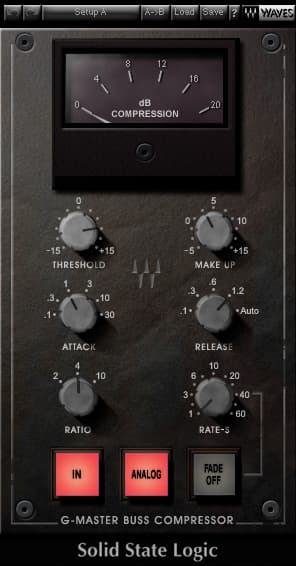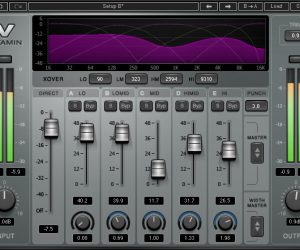
Side-Chain Filtering
Many up and coming engineers underestimate just how powerful the filters of a compressor’s side-chain can be. Although not as well known as their external side-chain brethren, side-chain filters bring amazing flexibility and creatively to the compression table.
Text: Mark Bassett
Before discussing the specifics of side-chain filters it’s worth noting the difference between parallel compression and side-chain compression.
The term ‘parallel compression’ – originally coined by Bob Katz (according to Bob himself at least) – refers to the process of taking a copy of an original signal, compressing it, and then blending the compressed signal back into the original uncompressed signal. This process has the effect of increasing the perception of low-level material, and for this reasons it’s often referred to as ‘upward compression’. Although this process is often confusingly termed ‘side-chain compression’, it doesn’t involve manipulating the side-chain signal beyond the traditional compressor controls.
All compressors utilise a side-chain circuit of some description. Modern compressor circuits generally split an audio signal in two, sending the original signal into the VCA (voltage control amplifier) whereupon its level is altered by the control voltage output of the side-chain circuit. It’s inside this circuit that the required amount of gain reduction for the compressor’s audio output is determined. The side-chain ‘split’ passes through the various parameters of the compressor: level detection, threshold, knee, ratio, attack and release.
The key concept to grasp is that standard everyday compression involves the use of the original signal to ‘compress itself’ via the side-chain. There’s also another type of compression that involves the use of an entirely separate signal to compress the original (using a kick drum signal to compress the bass guitar for example). This is known as external side-chain compression.
An external side-chain compression set-up involves sending an input signal (bass guitar for example) into a compressor, then, instead of splitting the bass guitar signal and using it to ‘compress itself’, via the internal side-chain, an external ‘key’ input signal (kick drum for example) is sent to the side-chain circuit. This kick drum signal is never heard (unless it’s present elsewhere in the mix). Rather, the kick drum signal is used to generate a control voltage, which ultimately controls the VCA that the original bass guitar passes through. Put another way, the kick drum is used to compress the bass guitar.
External side-chain compression is useful for specific types of effects, such as ‘ducking’ a bass guitar when the kick drum is present. However, within many compressors there are a series of controls that are often underestimated and overlooked: the side-chain filters.

ALTERING FREQUENCY RESPONSE
As discussed, standard compression involves using the original signal to ‘compress itself’. This type of compression uses an unaltered version of the original signal to pass through to the side-chain circuit. Put simply, side-chain filters alter the frequency response of the signal entering the internal side-chain circuit.
Perhaps the most common application of side-chain filters is the de-esser. A de-esser utilises a side-chain signal that’s overly sensitive to the sibilance frequency range. To construct a somewhat cumbersome de-esser using a side-chain filter, try this simple technique: engage the side-chain filters section of your compressor, filter the bottom-end out and apply a narrow boost around the 7kHz range. Set your attack and release to their fastest settings, and adjust the threshold accordingly.
Side-chain filters can be used to correct for the natural behaviour (frequency response) of the compressor itself. Compressors are more responsive (and therefore apply more gain reduction) to low frequencies, and can yield not only a compressed sound but a dull sound as well. This can be corrected by engaging the side-chain filters and applying a high-pass filter; removing all the low frequency content of the side-chain signal. This will make the compressor less responsive to low frequencies, resulting in more frequency-steady compression.
When compressing vocals, for instance, lower frequencies are higher in level when low notes are being sung. Couple this with the fact that compressors generally ‘hear’ low frequencies louder than high frequencies, and it’s likely that your compressor will immediately be more sensitive to the low-frequency content of the singer’s voice. This may yield more compression of low notes and less compression in the higher registers. Try applying a high-pass filter (HPF) to the side-chain to remove all the low frequency content. By making your vocal compressor only sensitive to 300Hz and up, vocal compression will only be triggered by mid and high frequencies, and as midrange frequencies are often fairly consistent in vocals – though not always – more even compression, that’s less sensitive to the fundamental pitch being sung, will result. Couple this HPF with a LPF (low-pass filter) set in the high-mids to focus the compressor’s detection circuit entirely on the midrange of the vocal. This technique also works well on bass guitar.


Remember that these filters are not applied directly to the original signal per se, so the vocal won’t suddenly sound thin and harsh. The internal side-chain filters only influence the side-chain signal, which is itself inaudible. The side-chain ‘split’ is only being used to alter the level of the original audio signal. It’s not – as many mistakenly think – being mixed back into the compressor’s output as a secondary audio signal.
Side-chain filters can be used to leave certain frequency ranges (and therefore certain instruments) out in terms of compression triggering. For example, when compressing room or overhead signals, try applying a high-pass filter around 200Hz and you will immediately hear the kick drum come through the compressor relatively unscathed. This is a great trick for those instances when you really want to slam your room mics but leave the kick alone. By attenuating bottom-end in the side-chain, low frequencies will generally sound louder in the compressed output as they trigger less compression. Conversely, by boosting 7kHz in the side-chain you make the compressor more sensitive to this frequency, causing it to become more prone to compression and therefore lower in level in the final compressed output. This demonstrates the inverse manner in which the side-chain filters affect the frequency response of the compressed signal. A low frequency cut in the side-chain will yield a relative low-frequency boost in the compressed signal and vice versa. Are your vocals losing their presence when you compress them heavily?
Apply a side-chain cut around 4kHz to yield a relative 4kHz increase in the compressed signal’s frequency response.
It’s clear that by equalising the side-chain, the frequency response of the compressed signal is affected. This should not, however, be confused with multi-band compression, where groups of frequencies are corralled by crossover filters and compressed independently of one another. While side-chain filters make a compressor more sensitive to the frequencies you exaggerate in the side-chain, they do not compress only these exaggerated frequencies. When the compressor finally reacts and gain reduction is applied, it’s applied across all frequencies. The main concept to grasp is that when you make a compressor super-sensitive to, say, sibilance frequencies, these will sound much louder to the compressor’s ‘ear’, allowing you to set a higher threshold that other instruments – like bass guitar – can sneak under undetected.
As we’ve seen, side-chain filters can be used to compensate for a compressor’s tendency to ‘hear’ bottom end as being louder, providing smoother compression that’s less sensitive to variations in the signal’s fundamental pitch. The topic of side-chain equalisation raises the inevitable question: ‘do I EQ before or after compression?’ While that’s another article entirely, the same reasoning applies. Ask yourself: ‘do I want my compressor to respond to my equalisation?’. The answer to this will help you decide whether to place an EQ before, after, or before and after your compressor.
Most modern compressors are based on a feed-forward design where the side-chain input is taken before the gain stage. For a detailed description of the inner workings of a compressor, check out Rob Squire’s On the Bench article on compressor side-chains in Issue 68 of AT.
















RESPONSES